SECTION 13-E 1950 BUICK CONVERTIBLE COUPE BODIES
13-23 OPERATION AND CARE OF FOLDING TOP
The folding tops on 1950 Buick convertible coupes are operated by the Hydro-Lectric Power System described in Section 13-F. The following instructions should be observed by anyone operating the top to raise and lower it.
Lowering the Top and Installing Boot
- STOP THE CAR. Turn down sunshades and pull rearward on locking handle above center of windshield. Push up the front of top to clear the windshield studs, then return locking handle to locked position.
- With ignition switch turned “ON,” pull top control knob rearward and hold it until top is fully lowered. It is not necessary to lower the rear quarter windows.
- After top is lowered, raise it slightly by hand and pull the top material out from under the rot f bow, so that it is in the position on the rear body panel shown in figure 13-46.
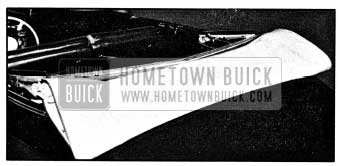
1950 Buick Top In Proper Position on Body Rear Panel
- Pull out top padding on both sides as shown in figure 13-47 and tuck it down into the top compartment. NOTE : Top material and padding must not be pinched by the operating arms of top.
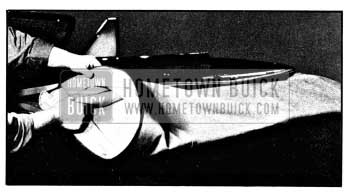
1950 Buick Pulling Out Top Padding
- Fold over the corners of top material, figure 13-48, then roll the material forward into a compact roll and tuck it down into the top compartment.
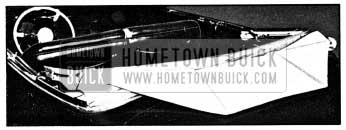
1950 Buick Corners of Top Material Folded Over
- Remove the leather “hold-down” strap from top boot storage bag and slip the end of it through the metal loop located down in the top compartment and also at the center of the front rail, then buckle securely. THIS IS IMPORTANT.
- Place top boot in position over the folded top so that snap fasteners on boot match buttons on belt molding, then snap into place the two rear center fasteners. Loop the fabric straps at inside corners of boot around the top operating arms and buckle snugly. Tuck the front outer flaps of boot down between the top linkage and the inside belt finishing molding, then attach the remaining snap fasteners.
Raising the Top
- STOP THE CAR. Remove top boot and unfasten “hold-down” strap. If thoroughly dry, top boot may be folded and placed in the storage bag. Place hold-down strap in storage bag.
- With ignition switch turned “ON,” push forward on top control knob and hold it until top is fully raised.
- Pull rearward on locking handle, draw top down over windshield studs, and push locking handle forward to locked position.
Emergency Operation of Folding Top
If it becomes necessary, in an emergency, to raise or lower the folding top when the ignition switch is locked and key is not available, or when the electrical system is inoperative, the top may be operated manually by slowly pushing or pulling on the top front rail. WARNING: Move top very slowly to avoid forcing fluid out of reservoir vent in the power unit. Hydraulic fluid is inflammable and detrimental to car paint. If fluid is lost through vent, reservoir must be refilled to proper level (par. 13-30).
Care and Cleaning of Folding Top
- In order to keep the mechanism in good working condition, the top should be operated at least once a month. Once a year, preferably in the Fall, the hydraulic fluid in the Hydro-Lectric Power System must be changed (par. 13-30).
- When the top is folded it MUST be securely strapped down to prevent chafing of top material. The locking handle must also be turned to a locked or horizontal position. Top boot can then be installed to keep top clean and dry.
- To avoid water stains, mildew, or possible shrinkage of the top material, do not permanently keep the top folded if it is damp or water soaked. Raise the top and fasten it above windshield and allow it to dry out. Keep back curtain raised when wet.
- Luggage and miscellaneous objects should not be placed on the folded top, as chafing action of such objects would damage the top material.
- The top compartment behind the rear seat must only be used for storage of the top when it is in a lowered position. The storage of luggage and miscellaneous objects in this compartment will not only interfere with the proper lowering of the top, but may damage or stain the top material or possibly be the cause of back curtain glass breakage.
- Avoid getting grease or oil spots on the top material because when either grease or oil is mixed with ordinary traffic grime it is particularly difficult to remove without leaving evidence of its having been cleaned.
- See paragraph 13-2 (e) for instructions on cleaning the top.
13-24 1950 BUICK FOLDING TOP AND REAR QUARTER WINDOW ADJUSTMENTS
Provision is made for the adjustment of the folding top to correct any variation the top linkage and mechanism may have through use.
Normally, the studs on top of windshield header should enter centrally into the guide plates in the top front roof rail. If the top is too far forward, or does not move forward far enough, difficulty may be experienced in latching and unlatching the top at this point. In some cases, more clearance may be needed between the underside of the roof rail and a rear quarter window or the top of a door window.
Service conditions will not be the same on all convertibles, therefore, each job must be carefully studied to determine which of the following adjustments are required. In some cases, a combination of several adjustments will be needed to secure proper top alignment and operation.
Adjustment of Top at Windshield
If the top, when in raised position, is either too far forward or back so that studs on windshield header do not enter centrally into the guide plates in top front roof rail, adjust as follows:
- Unlatch the top at windshield and raise top slightly.
- Loosen attaching bolts in corner brace at front end of roof side rail.
- The slotted holes in corner brace will allow a forward or rearward adjustment so that proper alignment may be made with the studs on top of windshield header. Tighten attaching bolts after proper alignment is obtained.
Adjustment of Top Up or Down
If the top side roof rail is too high or low in relation to the top of door or rear quarter window, adjust as follows:
- Unlatch the top at windshield and raise the top approximately half way.
- Remove rear seat cushion and back. Remove the rear quarter trim panel on the side to be adjusted.
- Loosen the three attaching bolts at top adjusting plate in rear quarter on side to be adjusted. See figure 13-49.
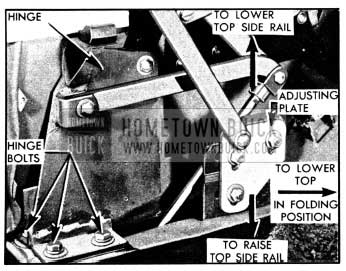
1950 Buick Top Adjusting Plate and Top Bow Hinge in Rear Quarter
Move adjusting plate straight downward to raise the roof side rail, or move plate straight upward to lower roof rail. CAUTION: Do not move adjusting plate forward or rearward since the folded position of top will be affected.
- Install rear quarter trim panel, seat back and seat cushion.
Adjustment for Folded Position of Top
If the top does not contact the bumper on each side of top compartment when it is down in folded position, loosen the three attaching bolts at top adjusting plate in rear quarter, move plate straight rearward and tighten bolts. See figure 13-49. CAUTION: Do not move plate vertically because this will affect the position of top roof side rail in relation to top of door and rear quarter windows.
Rearward movement of adjusting plate will lower the top further down in its compartment and will add materially to the fit of the top boot in cases where the original folded position of top was too high.
Adjustment of Top Side Rail
Weatherstrips to Rear Quarter Windows When the weatherstrip on a top side rail does not fit properly against the upper edge of a rear quarter window it may be adjusted by loosening the retaining nuts located inside the channel. The retainer bolt holes are slotted to permit lateral adjustment of the weatherstrip.
The weatherstrip at the curved rear end of each quarter window is attached by a sheet metal retainer. To adjust this weatherstrip, pry the beaded outer edge of weatherstrip out of retainer and remove. Loosen retainer attaching screws and shift the retainer as required, then tighten screws and install weatherstrip.
If the weatherstrip does not fit closely enough to the curved rear end of a quarter window, a limited adjustment may be obtained by removing weatherstrip and retainer and placing a waterproof cardboard shim between retainer and the top rear quarter rail. Another method of adjustment is to shift the top bow hinge which is mounted on the body in the rear quarter. By loosening the hinge attaching bolts (fig. 13-49) the hinge may be moved forward or rearward as allowed by oversize bolt holes in hinge. This adjustment also may be used if insufficient clearance exists between rear quarter window and the weatherstrip.
If the methods given above do not provide proper adjustment it will be necessary to adjust the rear quarter window as described below.
Adjustment of Rear Quarter Windows
The rear quarter windows may be shifted up or down, forward or rearward, and may be tilted laterally to provide proper alignment and clearance in relation to door window glass run channels and the weatherstrips on top side rails.
Each rear quarter window adjustment is a floating adjustment which is accessible after removal of the rear quarter trim panel. Loosening the two adjusting screw lock nuts and the window pivot bolt will permit shifting the window in direction required to secure proper alignment and clearance with adjacent parts. Turning the slotted adjusting screws will move upper edge of window inward or outward. See figure 13-50.
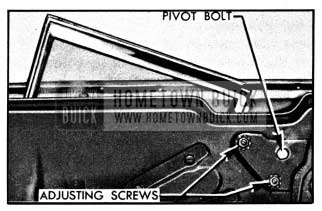
1950 Buick Rear Quarter Window Adjustments
After adjustment tighten adjusting screw lock nuts securely. Tighten pivot bolt firmly enough to prevent looseness and rattling of window but not so tight that window is hard to operate.
13-25 1950 BUICK DOOR, WINDOW AND VENTILATOR ADJUSTMENTS
Door hinges and the procedure for aligning doors on convertible coupes are similar to closed bodies described in paragraph 13-7.
On first convertible coupe bodies, a door frame stiffener rod runs diagonally from top front to lower rear corners of the door. The lower rear end of rod extends through the bottom flange of door and is provided with a slotted adjustable sleeve nut. If the lower rear corner of the door has a tendency to stand away from the adjacent body panel, it may be brought back into alignment by simply tightening the stiffener sleeve nut one or two turns. This adjustment also may have a tendency to raise the door slightly at the lock side. The adjustment mentioned also may be reversed, in the event the bottom lower rear corner of the door has a tendency to fit too close to the body.
On 1950 Buick convertible coupes, each door window glass is protected by a metal channel, and a window guide is located near the lock pillar to support rear edge of glass when in raised position. The glass run channel on lock pillar is adjustable to aid proper alignment of window glass with the folding top. The windows are operated by the Hydro-Lectric Power System described in Section 13-F.
Door ventilators on 1950 Buick convertible coupes are similar to ventilators on closed bodies except that each ventilator glass is supported by a frame which is attached to the door in such manner that ventilator may be adjusted to obtain proper alignment with window glass and folding top.
1950 Buick Door Window Guide and Lock Pillar Glass Run Channel Adjustments
Proper adjustment of the door window guide and the lock pillar glass run channel is necessary for free operation or travel of window glass. Adjustments of the window guide and the glass run channel must be made in conjunction with each other.
After removal of door trim pad (par. 13-18), the window guide may be adjusted forward, rearward, in, or out at both upper and lower ends as required. Guide attaching stud holes are slotted to provide forward or rearward movement of both ends of the guide. In or out movement is obtained by adding or removing washers on studs between window guide and door inner panel. See figure 13-51.
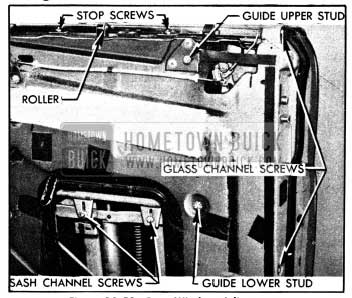
1950 Buick Door Window Adjustments
The lock pillar glass run channel may be adjusted to tilt the window glass inward or outward from a vertical line of travel. The hole in lock pillar at channel lower attaching screw is slotted to permit lateral movement of lower end of channel. Loosen upper attaching screw slightly then loosen lower screw and swing channel in required direction and tighten both screws.
Window Glass Travel Adjustments
If window glass does not travel high enough to cushion against the weatherstrip on underside of top side rail, or travels so high that it interferes with opening and closing of door, the maximum height of glass may be set by adjusting the stop screws located on upper edge of door inner panel. See figure 13-51.
When the window glass is all the way down, the upper glass channel should be flush with the top edge of door. If adjustment is required to obtain this fit, loosen the glass lower sash channel attaching screws, adjust glass up or down at each end as required, then tighten screws securely. See figure 13-51.
The anti-rattler rubber roller on top edge of door inner panel may be adjusted in or out to secure proper contact to cushion the glass against vibration or shock when door is slammed shut. Adjust these rollers to a uniform light contact with window glass. See figure 13-51.
If the height of window glass is changed very much it may be necessary to change the height of the ventilator (subpar. c), to maintain proper alignment of window glass and ventilator.
Door Ventilator Adjustments
If the door ventilator is not in proper alignment with door window glass after adjustment of the latter, the ventilator assembly and . the division channel may be adjusted to obtain alignment as follows:
- To move upper end of ventilator inward or outward, loosen the ventilator frame adjusting screw lock nut and turn adjusting screw as required. It may be necessary to loosen the two upper screws slightly. Tighten upper screws and adjusting ,screw lock nut when adjustment is completed. See figure 13-52.
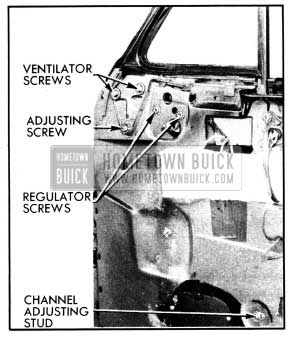
1950 Buick Door Ventilator Adjustments
- With frame attaching screws loosened, the ventilator may be shifted forward or rearward as required.
- Adjust division channel in required direction by means of the adjusting stud at lower end of channel. See figure 13-52.

Leave A Comment
You must be logged in to post a comment.